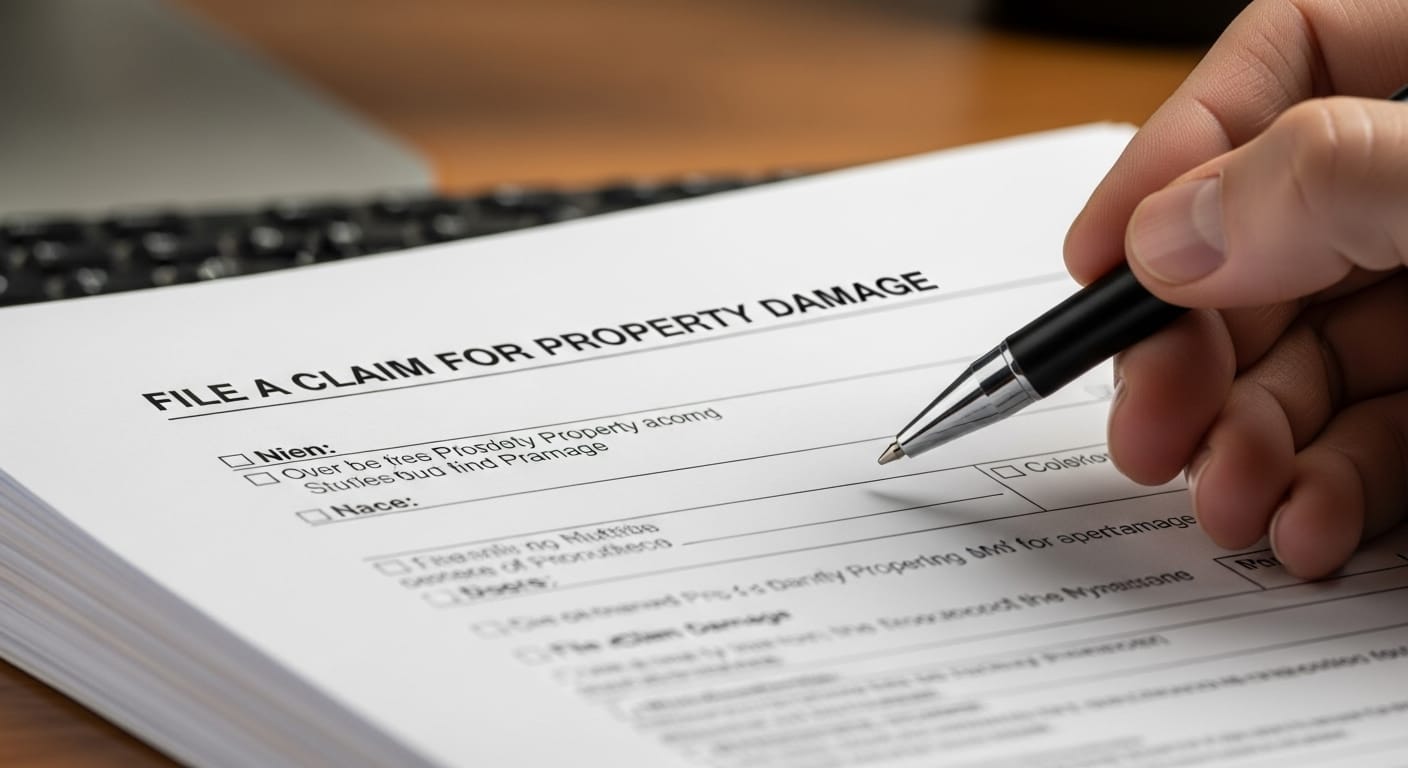Please Note: This post may contain affiliate links. If you click one of them, we may receive a commission at no extra cost to you. As an Amazon Associate, I earn from qualifying purchases.
So, your house got hit by a freak storm, or maybe a rogue tree decided your roof looked like a nice landing pad.
Either way, you’re staring at the aftermath, trying to figure out how to get your insurance to cover the damage without ending up in a wrestling match over paperwork. Filing a property damage claim can feel like trying to read a map without any directions, but trust me, it’s not as daunting as it seems.
To help you avoid unnecessary stress and confusion, here’s a straightforward guide on how to file a claim for property damage and hopefully get compensated for your troubles. And yes, there’s even a chance you’ll get paid back for that outrageous damage to your lawnmower, or whatever else the storm decided to eat.

Top Takeaways and Key Concepts
Assess and document all property damage thoroughly before contacting your insurance company.
Provide clear, accurate details when reporting the claim, including policy number, cause, and date.
Complete claim forms carefully, asking questions if any instructions or details are unclear.
Cooperate with the insurance adjuster, providing honest information and supporting evidence for full compensation.
Review settlement offers carefully, negotiate if necessary, and consult an attorney for disputes or denials.
Summary of This Article
The article provides a step-by-step guide to filing a property damage insurance claim. It emphasizes assessing and documenting damage, contacting the insurer with clear details, and completing claim forms accurately. The insurance adjuster’s role is explained, highlighting the importance of honesty and thorough evidence. Policyholders are encouraged to carefully review and negotiate settlement offers, ensuring fair compensation. Finally, the article advises seeking legal help if the claim is denied or the settlement is insufficient, ensuring rights are fully protected.
Assessing the Damage

Before you even think about picking up the phone to call your insurance company, take a deep breath and start assessing the damage. You don’t want to be that person who calls their insurer in a panic only to realize you’ve been freaking out over a tree branch that’s blocking your driveway but didn’t really cause any damage.
First things first: Don’t touch anything that’s damaged if it’s dangerous or could make things worse. So, if your roof’s caved in and there’s debris everywhere, don’t go playing handyman just yet.
Document everything. Get photos, take video, and make sure the damage is well documented. Honestly, the more proof you have, the better. It’s like making sure you have your receipt when returning that blender you didn’t really need.
By the way, you’re going to want to document everything. I mean everything. The more evidence, the less likely your insurer will try to pull some fast one on you.
Contacting Your Insurance Company
Once you’ve had a chance to assess the damage (and take a few deep breaths), it’s time to contact your insurance company. When you call, make sure to have all the details ready. Think of it like a game of 20 questions, but you’re the one asking.
Start with your policy number, the cause of the damage, and a quick rundown of what happened. You want to be as clear as possible so that you don’t end up in an endless loop of phone calls. It’s like making a reservation at a restaurant: If you don’t confirm all the details, the chances of getting the wrong table are high.
Interestingly enough, some insurance companies offer online claim filing systems, so you may not even have to wait on hold for 20 minutes. Which is great, because, let’s face it, no one wants to be stuck listening to elevator music.
Filling Out the Claim Forms
Here comes the fun part: paperwork! Oh, joy. Filing a claim for property damage means filling out forms that range from basic to borderline insane. But don’t worry. It’s not as bad as it seems.
The forms will typically ask for the following: a description of the damage, the date it occurred, and the specific cause. But here’s where you need to pay close attention. Make sure everything is accurate. If you’re vague about what happened, you’re opening the door for your claim to be delayed, or worse, denied.
As a matter of fact, if you’re unsure about anything on the form, don’t hesitate to ask the insurance company for clarification. You’re the one dealing with the damage, so you might as well get it right.
The Adjuster’s Visit
After you’ve submitted your claim, an insurance adjuster will be sent to assess the damage. Yes, that’s right. Someone gets to come to your house, take a look at everything, and decide how much you’ll get paid. Think of them like the referee in a sports game—only their call can make or break your day.
The adjuster will inspect the damage and might ask some follow-up questions. It’s basically their job to determine if the damage falls under your policy and how much it’s worth. The key here is to be honest and thorough. If you’re worried about the adjuster undervaluing your damage, you can always get a second opinion (or even hire your own expert).
Then again, don’t go expecting the adjuster to be a miracle worker. If your roof’s gone and you’ve got a puddle forming in the living room, they’ll probably be able to help, but you’re going to need a solid argument to get the full compensation.
Negotiating the Offer
Let’s say the adjuster leaves, and you receive an offer from your insurance company. At this point, it’s not time to celebrate just yet. In fact, you might want to channel your inner negotiator. You see, insurance companies are like used car salesmen—they don’t always offer you the best deal right off the bat.
Take a good look at the offer. Does it seem fair? Does it cover the actual cost of repairs? If not, don’t be afraid to push back. It’s your right to negotiate. Let them know why their offer isn’t cutting it, and back it up with facts, estimates, and the evidence you’ve gathered.
Honestly, sometimes just being persistent is all it takes. Don’t let them off the hook with a lowball offer. You’re not asking for a Lamborghini here; you’re asking for fair compensation to fix what was broken.
Finalizing the Claim
Once you’ve reached an agreement with your insurer (whether you’ve negotiated a higher payout or not), it’s time to finalize the claim. This usually involves signing some forms and agreeing to the settlement amount.
Now, here’s where you need to keep your eyes peeled. Make sure everything in the settlement agreement matches what was promised. Once you sign that paperwork, it’s a done deal.
Interestingly enough, sometimes insurance companies will try to sneak in clauses or stipulations that you didn’t agree to, so read everything carefully. If something feels off, ask questions before signing. It’s like buying a house—don’t skip the inspection.
Seeking Legal Help
If your claim is denied or you’re not happy with the settlement offer, it may be time to consult an attorney. If you’re facing a property damage claim that’s not going the way you planned, a lawyer can help you understand your options and fight for the compensation you deserve.
In fact, if you’ve tried negotiating with the insurance company but they’re still dragging their feet, it’s time to lawyer up. A good attorney can take your case and make sure the insurance company plays by the rules.
Resources
How to File an Insurance Claim
http://www.claimsadvisor.com/file-claim
What to Do if Your Property Damage Claim is Denied
http://www.claimsdenialguide.com/denied-claims
Property Damage Legal Resources
http://www.propertydamageattorneys.com
Frequently Asked Questions
What should I do first after discovering property damage?
Start by assessing and documenting all damage thoroughly with photos and videos. Avoid making repairs that could alter evidence until your insurance company inspects the property.
When should I contact my insurance company about the damage?
Contact your insurer as soon as possible after documenting the damage. Provide details such as your policy number, cause of damage, and the date the incident occurred.
What information is needed to file a property damage claim?
You’ll need your policy number, a detailed description of the damage, the cause, and supporting evidence like receipts or repair estimates to ensure accuracy and faster processing.
What is the role of an insurance adjuster during the claim process?
The adjuster inspects your property, evaluates the damage, and determines the settlement amount based on your policy coverage and the evidence you provide.
Can I negotiate if I disagree with the insurance company’s settlement offer?
Yes. Review the offer carefully and present documentation, repair estimates, or additional evidence to support a fairer compensation amount before finalizing the claim.
What should I check before signing the final settlement agreement?
Ensure the settlement matches the agreed terms and compensation amount. Read all documents thoroughly, and don’t sign until any unclear clauses are clarified by your insurer or attorney.
When should I hire an attorney for a property damage claim?
If your claim is denied or the settlement offer seems unfair, consulting a property damage attorney can help you dispute the decision and pursue full compensation.

Kevin Collier is a legal expert passionate about simplifying complex legal concepts for everyday individuals. With a focus on providing clear, practical information, he covers a wide range of topics, including rights, responsibilities, and legal procedures. Kevin aims to empower readers with the knowledge they need to navigate the legal landscape confidently, ensuring they can make informed decisions regarding their legal matters. Through insightful articles and easy-to-understand resources, he helps demystify the law, making it accessible to all.










